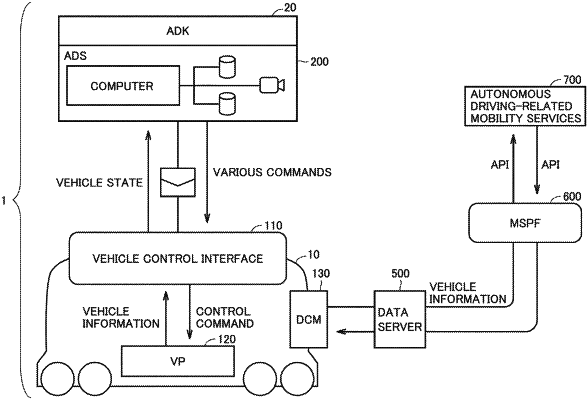| CPC B60W 30/09 (2013.01) [B60W 10/18 (2013.01); B60W 30/0953 (2013.01); B60W 30/0956 (2013.01); B60W 60/001 (2020.02); B60W 2510/188 (2013.01)] | 12 Claims |

|
1. A vehicle comprising:
an autonomous driving system; and
a vehicle platform that controls the vehicle in response to a command received from the autonomous driving system, wherein:
the autonomous driving system sends to the vehicle platform a command including a first command to request acceleration and deceleration and a second command to request to maintain stationary,
the first command indicates a positive value when acceleration is requested,
the first command indicates a negative value when deceleration is requested,
the autonomous driving system obtains a first signal indicating a longitudinal velocity of the vehicle, a second signal indicating whether the vehicle is at a standstill, and a third signal indicating a moving direction of the vehicle, and
when the first signal indicates 0 km/h or a prescribed velocity or less after the autonomous driving system issues the first command indicating a negative value to request the vehicle platform to provide deceleration to stop the vehicle, the autonomous driving system issues the second command to request the vehicle platform to maintain stationary,
the third signal indicates standstill when a prescribed number of wheels of the vehicle continue at a speed of 0 km/h for a prescribed period of time,
brake hold control is started when the first command requests deceleration, the second command requests the vehicle to be maintained stationary, and the third signal indicates standstill,
when the request through the first command for deceleration is canceled while the brake hold control is being performed, the brake hold control is aborted,
when the request through the second command to maintain the vehicle stationary is canceled while the brake hold control is being performed, the brake hold control is aborted,
when the third signal does not indicate standstill while the brake hold control is being performed, the brake hold control is aborted, and
after the brake hold control is finished, the second signal indicates standstill,
further comprising a vehicular body which the autonomous driving system is mountable on and removable from, wherein:
the vehicular body includes the vehicle platform and a vehicle control interface,
the vehicle control interface mediates communication of a signal between the vehicle platform and the autonomous driving system,
the vehicle platform includes a system, a sensor, and a control device configured to control the vehicular body,
the vehicle without the autonomous driving system is travelable with the vehicular body alone, and
the vehicle control interface includes a processor,
further wherein:
the vehicle control interface converts the command received from the autonomous driving system into a format of a signal that can be processed by the vehicle platform, and sends the converted command to the vehicle platform,
the vehicle platform detects a state of the vehicular body, and sends a detection signal indicating the detected state of the vehicular body to the vehicle control interface, and
the vehicle control interface obtains a state signal indicating the state of the vehicular body based on the detection signal, and outputs the state signal to the autonomous driving system, the state signal including the first signal and the second signal, and
wherein the vehicle platform is further configured to:
calculate an acceleration provided at a time of wide open throttle (WOT),
estimate a value of a possible maximum acceleration based on the calculated acceleration, a current state of the vehicle, and a current road surface condition, and
output the estimated value to the vehicle control interface.
|